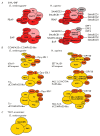Polycomb and Trithorax Group Proteins: The Long Road from Mutations in Drosophila to Use in Medicine
- PMID: 33456979
- PMCID: PMC7800605
- DOI: 10.32607/actanaturae.11090
Polycomb and Trithorax Group Proteins: The Long Road from Mutations in Drosophila to Use in Medicine
Abstract
Polycomb group (PcG) and Trithorax group (TrxG) proteins are evolutionarily conserved factors responsible for the repression and activation of the transcription of multiple genes in Drosophila and mammals. Disruption of the PcG/TrxG expression is associated with many pathological conditions, including cancer, which makes them suitable targets for diagnosis and therapy in medicine. In this review, we focus on the major PcG and TrxG complexes, the mechanisms of PcG/TrxG action, and their recruitment to chromatin. We discuss the alterations associated with the dysfunction of a number of factors of these groups in oncology and the current strategies used to develop drugs based on small-molecule inhibitors.
Keywords: Drosophila; EZH2 inhibitors; PRC2; PRC2 inhibitors; PRE; Polycomb; Trithorax; cancer, oncology; small-molecule inhibitors.
Copyright ® 2020 National Research University Higher School of Economics.
Figures





Similar articles
-
From genetics to epigenetics: the tale of Polycomb group and trithorax group genes.Chromosome Res. 2006;14(4):363-75. doi: 10.1007/s10577-006-1069-y. Chromosome Res. 2006. PMID: 16821133 Review.
-
Genome-wide RNAi screen in Drosophila reveals Enok as a novel trithorax group regulator.Epigenetics Chromatin. 2019 Sep 23;12(1):55. doi: 10.1186/s13072-019-0301-x. Epigenetics Chromatin. 2019. PMID: 31547845 Free PMC article.
-
A genome-wide computational approach to define microRNA-Polycomb/trithorax gene regulatory circuits in Drosophila.Dev Biol. 2023 Mar;495:63-75. doi: 10.1016/j.ydbio.2022.12.008. Epub 2022 Dec 31. Dev Biol. 2023. PMID: 36596335
-
A vertebrate Polycomb response element governs segmentation of the posterior hindbrain.Cell. 2009 Sep 4;138(5):885-97. doi: 10.1016/j.cell.2009.08.020. Cell. 2009. PMID: 19737517
-
PcG and trxG in plants - friends or foes.Trends Genet. 2015 May;31(5):252-62. doi: 10.1016/j.tig.2015.03.004. Epub 2015 Apr 6. Trends Genet. 2015. PMID: 25858128 Review.
Cited by
-
Roles of Polycomb complexes in regulating gene expression and chromatin structure in plants.Plant Commun. 2021 Nov 26;3(1):100267. doi: 10.1016/j.xplc.2021.100267. eCollection 2022 Jan 10. Plant Commun. 2021. PMID: 35059633 Free PMC article. Review.
-
Bivalent Regulation and Related Mechanisms of H3K4/27/9me3 in Stem Cells.Stem Cell Rev Rep. 2022 Jan;18(1):165-178. doi: 10.1007/s12015-021-10234-7. Epub 2021 Aug 21. Stem Cell Rev Rep. 2022. PMID: 34417934 Review.
-
Clinical Correlations of Polycomb Repressive Complex 2 in Different Tumor Types.Cancers (Basel). 2021 Jun 24;13(13):3155. doi: 10.3390/cancers13133155. Cancers (Basel). 2021. PMID: 34202528 Free PMC article.
-
Crol contributes to PRE-mediated repression and Polycomb group proteins recruitment in Drosophila.Nucleic Acids Res. 2023 Jul 7;51(12):6087-6100. doi: 10.1093/nar/gkad336. Nucleic Acids Res. 2023. PMID: 37140047 Free PMC article.
-
Comparative interactome analysis of the PRE DNA-binding factors: purification of the Combgap-, Zeste-, Psq-, and Adf1-associated proteins.Cell Mol Life Sci. 2022 Jun 9;79(7):353. doi: 10.1007/s00018-022-04383-2. Cell Mol Life Sci. 2022. PMID: 35676368 Free PMC article.
References
-
- Chetverina D.A., Elizar’ev P.V., Lomaev D.V., Georgiev P.G., Erokhin M.M.. Genetika. 2017;53(2):133–154. - PubMed
LinkOut - more resources
Full Text Sources
Molecular Biology Databases
